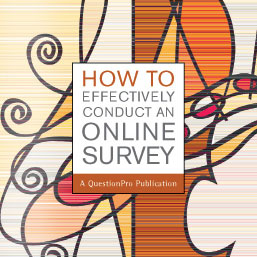Types of Questions: Sample Question Types with Examples
What is a Question?
A question is a sentence that seeks an answer for information collection, tests, and research. Right questions produce accurate responses and aids in collecting actionable quantitative and qualitative data.
Questions have over the years evolved to different question types to now collect different sets of information. The types of question used in a research study are decided by the information required, nature of the study, the time needed to answer, and the budget constraints of a study.
The art of asking the right questions helps to gain deep insights, make informed decisions, and develop effective solutions. To know how to ask good questions, understand the basic question types.
Below are some widely used types of questions with sample examples of these question types:
The dichotomous question is generally a "Yes/No" close-ended questionand used for basic validation. In the below example, a yes or no question is used to understand if the person has ever used your online store to make a purchase. The respondents who answer "Yes" and "No" can be bunched together into groups. Then, you can ask different questions to both groups.

Multiple choice questions are a question type in which respondents have to select one (single select multiple choice question) or many (multi-select multiple choice question) responses from a given list of options. The multiple-choice question consists of an incomplete stem (question), right answer or answers, incorrect answers, close alternatives, and distractors. However, the questions are designed as it best matches the expected outcome. Typically, single select questions are denoted by radio buttons, and multi-select questions are denoted by check-boxes. An example of a multi-select multiple-choice question is a bank that would like to launch a new credit card and wants to understand payment merchants' usage:
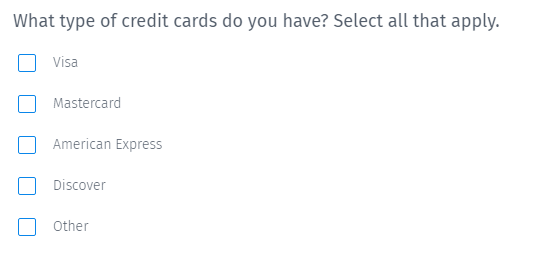
This helps the bank understand the preference of payment merchant and use that in their new product launch.
The rank order question type allows the respondent to rank preferences in a question in the order of choice. Use this question type to understand the weightage that is offered by respondents to each option. The other type of rank order question is a drag and drop question type, where the respondent can rearrange options based on importance. An example of a rank order question is a sports goods store looking to understand from respondents their choice of sports and the order they would place them.

A text slider question is a rating scale question type that uses an interactive slider in answer to select the most appropriate option. The options scale is well-defined and on the same continuum. Rating scales are used to measure the direction and intensity of attitudes. You can also use a text slider where either end of the option has an anchor.

Likert Scale is one of the most used tools by market researchers to evaluate their target audience's opinions and attitudes. This type of question is essential in measuring a respondent's opinion or belief towards a given subject. The answer options scale is typically a five, seven, or nine-point agreement scale used to measure respondents' agreement with various statements. Likert scales can be unipolar, indicating a respondent to think of the presence or absence of quality. Or they can be bipolar, mentioning two different qualities, and defining the relative proportion of those qualities. For example, if a telecom company would like to understand the respondent's satisfaction level with their services, the question that can be asked is:

Semantic differential scale is a type of question that asks people to rate a product, company, brand, or any "entity" within the frames of a multipoint rating option. These survey answering options are grammatically on opposite adjectives at each end. For example, if the national health association wants to collect feedback on Government insurance policies from the general public, the following question could be administered.

The Stapel scale question is a close-ended rating scale with a single adjective (unipolar), developed to gather respondent insights about a particular subject or event. The survey question comprises an even number of response options without a neutral point. For example, if an airline wants to collect feedback on multiple attributes of a respondent's flying experience.

Constant Sum question is also a rank order question type where the respondent can only select options in the form of numerics. A constant sum question allows respondents to enter numerical values for a set of variables but requires them to add up to a pre-specified total. Each numeric entry is summed and can be displayed to the respondent. It is a great question type to use when asking financial, budget-related questions, or percentage based questions. An example of this question type is collecting data on how respondents allocate monthly budgets based on their income.
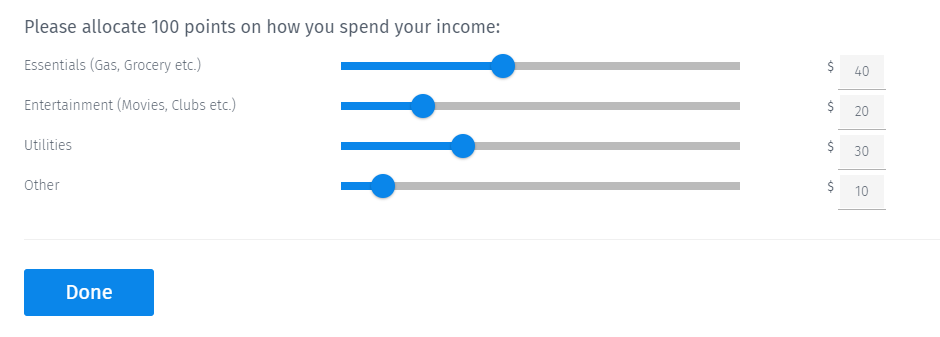
The comment box open-ended question is used to collect any feedback or suggestions that could be very long. They are open text format such that the respondent can answer based on their complete knowledge, feelings, and understanding. Hence, this question type is used when the organization conducting the study would like to justify a selection in a prior question or when extensive feedback is required from the respondent.

A text question is similar to a comment box, but the data to be entered is generally regulated and requires validation. This type of question has three sub-types:
- Single row text: One line of text can be inputted, for example, house address.
- Numeric textbox: Only numbers can be entered. The use of other characters will throw an error—for example, contact number.
- Email address: Insert email address for further correspondence.

This question type is an open-ended question with multiple rows of text indicated with a title, and the textual characters are regulated. This type of question collects respondent information like full name, address, email address, phone number, age, and sex.
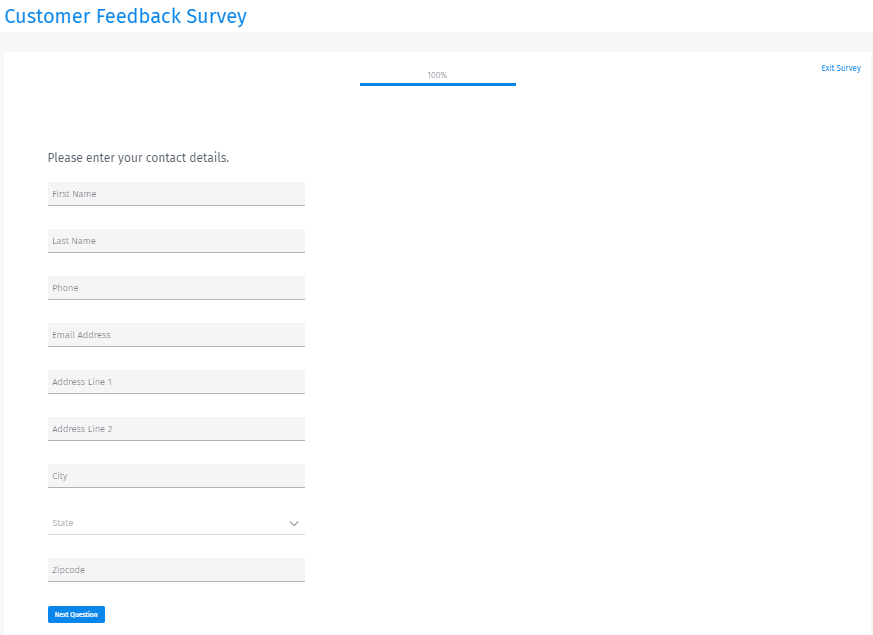
The demographic question captures the demographic data from a population set. They are used to identify age, gender, income, race, geographic place of residence, number of children, etc. Demographic data helps you paint a more accurate picture of the group of people. For example:
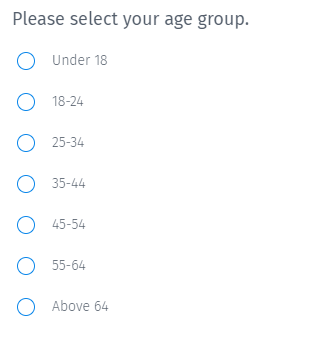
Matrix table questions are arranged in tabular format with questions listed on the left of the table while the answer options are at the top of the table. There are multiple variants of the matrix table question type. Multipoint matrix table questions use radio buttons to select answers for multiple aspects in a question. Multi-select matrix table questions use check-box buttons to select answers. The spreadsheet matrix table question is used to insert text while answering questions. An example of this is if an organization wants to collect feedback on specific attributes; the question that can be asked is:

In case you have to organize a survey to know the importance and satisfaction level of the various services offered to users, you can use side-by-side matrix question. It gives you the option to define multiple rating options simultaneously. The side by side matrix question makes it easy to identify your strengths and improvement areas.
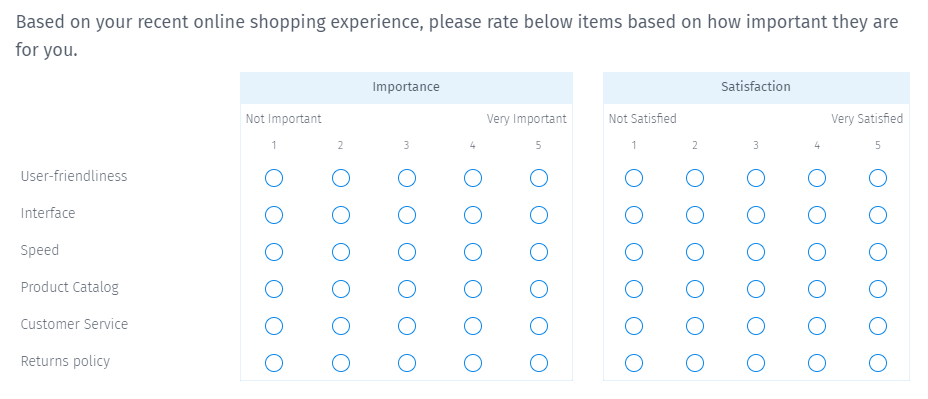
The star rating question is a type of rating questionthat uses an odd number of stars to rank attributes or display feelings and emotions. An odd number matrix type question is used to account for a middle or neutral point in a rating survey. Higher the number of stars, higher is the agreement with a statement. This question type allows for a rating on multiple rows to be collected for one single topic. For example, if a retail brand wants to gather feedback about their brand, they can use a star rating question in the following format:

Maximum Differential Scaling or Max-Diff is a question type where respondents are given a set of attributes and asked to indicate the best and the worst attributes. There could only be one of each option in the final response. For example, if a bank wants to understand the preference of payment merchant, the question can be asked in the following format:

Push to social question type allows you to share reviews or feedback to social media sites like Facebook, Twitter, and Google +. It is used to create a positive vibe about your brand on social media. Alternatively, you can address customer satisfaction issues and negative feedback before they go out on social media.

The visual analog question is a close-ended question that can be administered in two ways - a Thumbs Up/Thumbs Down question type and an odd-point smiley question.
The thumbs up and thumbs down question is a two-point question where respondents have to indicate their feelings or opinions with either a positive or negative answer. An example of this question type is a respondent's emotion towards their experience at Starbucks.

The smiley rating question type generally consists of a 5 point rating scale indicated with a neutral point. Due to the question's visual representative nature, the response rate for this question type is always higher. An example of this question is a retail brand looking to collect feedback with the purchase experience.

The image question is used to increase the response rate of respondents as it allows them to click on images as their answer option to a question. For example, to understand a respondent's favorite ice cream flavor, the question can be administered as:

A Net Promoter Score (NPS) is a question type sent to customers to get a concise understanding of their satisfaction level with your brand or organization. This question is imperative for understanding the level of customer satisfaction. Response to this question is measured on a scale of 0-10. It provides a simplified, yet a highly effective vision of an organization's brand popularity and identifying potential brand promoters or detractors among existing customers. Respondents to this question are categorized as:
- Detractors: Who gave a score between 0 and 6.
- Passives: Who gave a score between 7 and 8.
- Promoters: Who gave a score between 9 and 10.

The Van Westendorp-Price Sensitivity question is a technique for market researchers to gauge consumer perceptions of products or services' value. It helps in understanding the scope to tweak the price and offering. For example, if a software product manufacturer wants to know how to price a product, the following question could be asked:
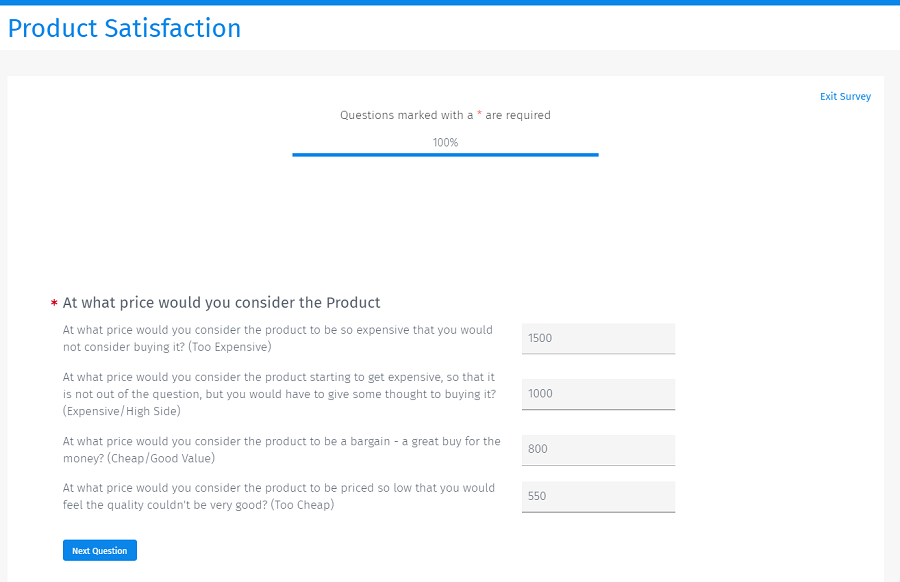
Date/Time question type allows you to collect date/time information filled in by a respondent consistently. For example, questions related to the date of birth can be answered using this question.

This question type is used to limit the phony responses in a survey or data collection by automated computer programs.
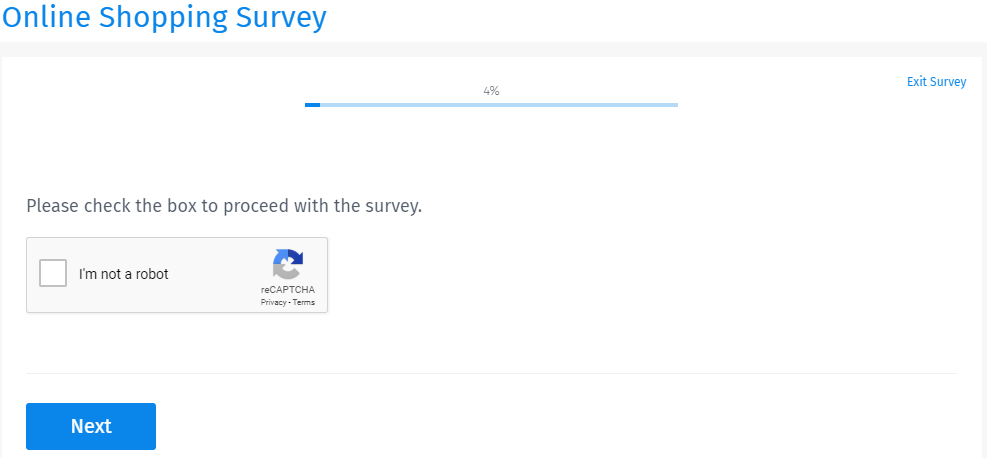
The calendar question allows the respondent to input a date and time in the calendar format. For example, to input date of birth.
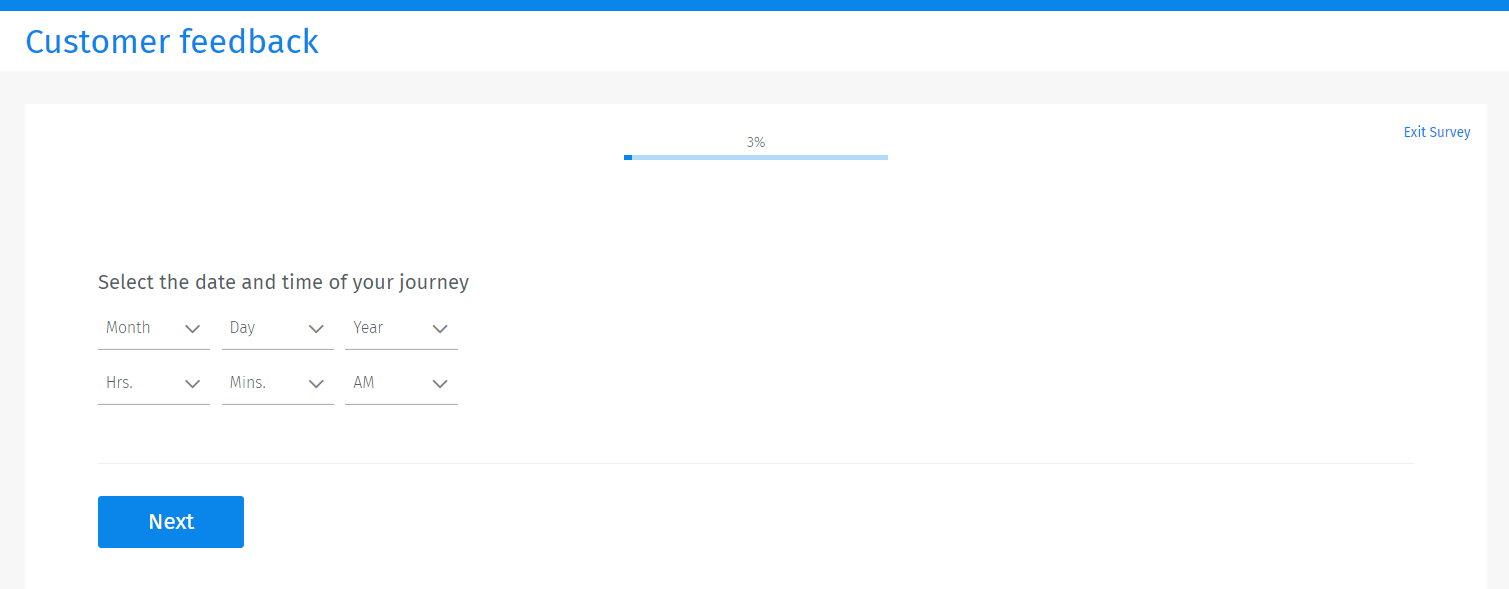
Interactive map questions allow a respondent to click on a location by hovering over or clicking on an interactive map. When the respondent scrolls over the map, a selection can be made based on the pop-up at the point of hover. For example, if a respondent is asked for the birth state or city, he/she can hover over the map to select the correct location.

This question can be used to validated zip codes against those in the databases for a given country. For example, if respondents fill in his/her zip code and need to check if it's correct as per standard US postal zip code, they can use this question type.

The lookup table question type offers to autocomplete information systematically. It is a mix of drop-down and single-line editable textbox. This question type is used when there are many options, and the correct choice is displayed when the respondent starts typing.

This question type helps to locate a nearby store in a region for business purposes within proximity of an address or area.
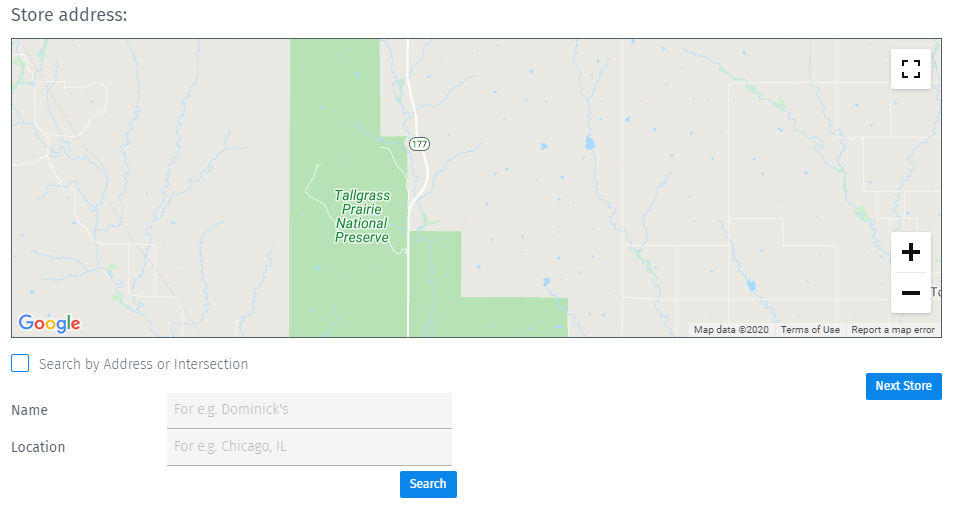
This question type allows the respondent to provide feedback or indulge in a discussion about a specific topic. The stimulating subject is depicted with a video. For example, if an organization wants to collect feedback on a shopping experience, feedback can be obtained by:
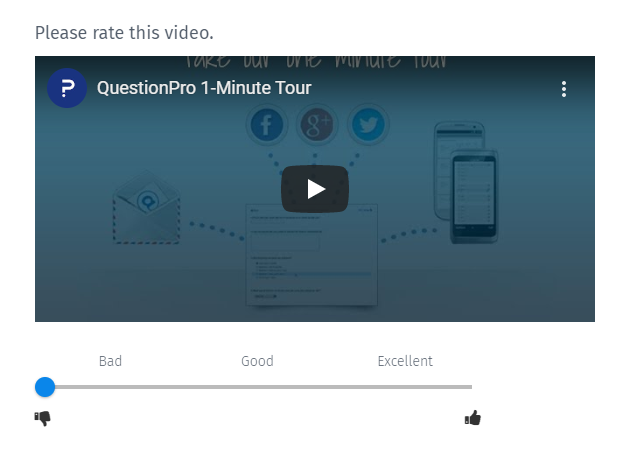
 Survey software
Easy to use and accessible for everyone. Design, send and analyze online surveys.
Survey software
Easy to use and accessible for everyone. Design, send and analyze online surveys.
 Research Suite
A suite of enterprise-grade research tools for market research professionals.
Research Suite
A suite of enterprise-grade research tools for market research professionals.
 CX
Experiences change the world. Deliver the best with our CX management software.
CX
Experiences change the world. Deliver the best with our CX management software.
 Workforce
Create the best employee experience and act on real-time data from end to end.
Workforce
Create the best employee experience and act on real-time data from end to end.






























